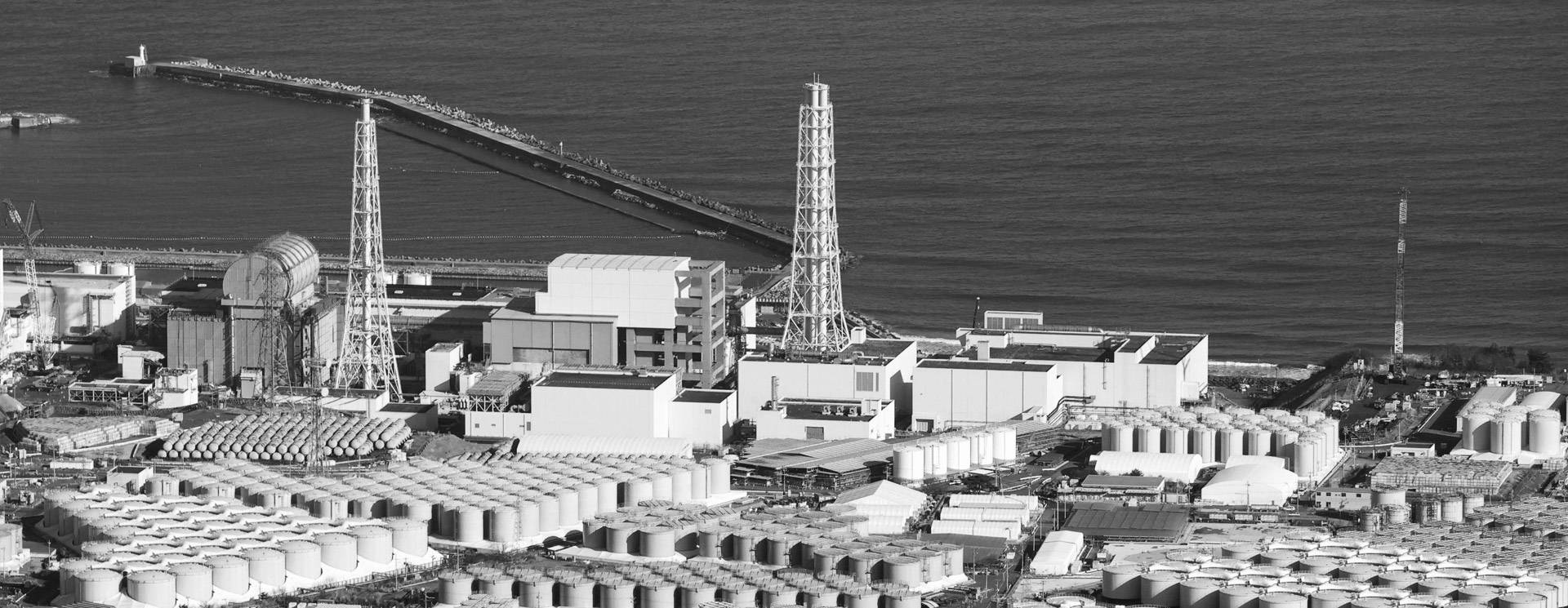
Vedio link: https://mp.weixin.qq.com/s/19YNgmVX84hauVgY8ICALw
福岛核污染水是怎样产生的?
主持人:各位,这里是绿色江南《福岛核污染水专题》访谈面对面,我是主持人雨歌。
自2011年3月日本福岛核电站发生重大核事故,福岛核电站为了冷却熔毁的核反应堆,向熔毁的核反应堆灌注大量的海水,而这些产生的大量含有极高的放射性元素的核污染水何去何从引发全球关注。今天我们面对面访谈绿色江南公众环境关注中心方应君主任
主持人:在2011年3月日本福岛核电站因地震发生核事故,产生了大量的核污染水,日本政府不顾国际反对的声音,执意将要把130多万吨核污染水排放大海,请问方主任,日本福岛核污染水是怎样产生的?
方应君:在2011年3月11日,日本福岛县附近海域发生9级特大地震,地震引发的巨大海啸袭击了福岛第一核电站。由于地震而造成的长时间断电,造成了核电站1至3号机组反应堆内的核燃料棒无法得到足够的冷却水冷却,导致了核反应堆堆芯内的冷却水温度不断升高、沸腾,然后产生高温高压的蒸汽开始向厂房内泄漏。核燃料棒池的冷却水开始慢慢被蒸发干净,核燃料棒开始裸露在空气中,彻底失去了冷却。由于熔毁堆芯的水蒸汽蒸发很快直接导致缺水,造成核电站1至3号机组堆芯的核燃料棒开始熔毁,失去冷却的核燃料棒与含有放射性元素和水蒸汽发生反应,产生了大量的氢气从毁坏的反应堆溢出,甚至从反应堆厂房向外泄漏,致使厂房发生剧烈爆炸。
为了给熔毁的反应堆堆芯冷却(在这里需要提醒的是,熔毁的堆芯就是核残渣),于是乎,东电公司不断地向熔毁的堆芯注入了大量的海水,而这些大量的海水、是直接来冷却接触熔毁的堆芯核残渣的,因此,这些用来冷却的海水是含有极高浓度的放射性元素。
据媒体报道,2011年4月2日发生了让全球更担心的事故,因爆炸厂房机组的底层产生了大量裂缝,也就是2号机组海水取水处附近的混凝土竖井出现裂缝,高放射性污染水正在向裂缝中泄漏,直接向大海排放1至4号机组集中废弃物处理设施等存储的约9000多吨高浓度放射性核污染水,这样的排放一直持续到4月6日才停止。
也就是说,在事故发生之初就有大量冷却熔毁堆芯的含有高浓度放射性元素的核污染水随着爆炸产生的裂缝直接流入大海,直接污染了我们的海洋。
主持人:那产生这么多核污染水,日本政府会怎么积极应对呢?
方应君:当初日本政府为了储存这些能收集的大量核污染海水,就在福岛县建设了1000个左右的储水罐,目前核污染水的储存量已经远远超过了130万吨。
在就日本福岛核电站发生核事故产生大量的核污染水之前,全球并没有发生同类产生如此大量核污染水的事故,所以没有可参照的处理方法。就目前人类所掌握的科技技术是没有办法一次性安全处理这么巨大体量的核污染水。最好的处理办法就是先收集、储存、再深度处理,然后满足核污染水多种放射性元素的半衰期后安全排放(我们要知道,有的放射性元素的半衰期需要几百万年,如镎237,它的半衰期高达217万年),但这恰恰是日本政府所不能接受的,那将是一个持续耗费巨资的漫长时期。
所以、日本政府不顾国际社会谴责的声音,公然违背国际公约,为了自身的经济利益,选择一排了之的做法,将核污染水直接排向大海,破坏全球的海洋生态环境,让全球的人类为日本政府的错误行为买单。
主持人:距离2011年日本福岛核电站爆炸至今已经有11年了,如何处理福岛核事故第一核电站堆芯熔毁的反应堆冷却产生的核污染水,是安全处理还是直接排放入海,摆在日本政府面前的将是一道艰难的选择题。关于福岛核污染水的后续进展,我们将持续关注。
福島の核汚染水はどのようにして発生したのか?
司会:皆さん、ここは緑色江南「福島原発汚染水特集」対面インタビュー、私は司会の雨歌です。
2011年3月、日本の福島原発で大事故が起きて以来、福島原発は原子炉を冷却するため、溶融した原子炉に大量の海水を注入しましたが、極めて高い放射能を含む大量の汚染水がどうなるのか、世界的な関心を呼んでいます。極めて高濃度の放射性元素を含む核汚染水が大量に発生し、今後どうなるのかが世界的な関心を呼んでいます。 本日は、緑色江南公共環境配慮センターの方応君主任にお話を伺います。
司会:2011年3月、日本の福島原子力発電所で地震による原発事故が発生し、大量の核汚染水が発生しました。日本政府は、国際的な反対にもかかわらず、130万トン以上の核汚染水を海に放出することを主張しましたが、方主任、福島の核汚染水はどのようにして発生したのか、お伺いしてもよろしいでしょうか?
方応君主任: 2011年3月11日、日本の福島県付近の海域でマグニチュード9の巨大地震が発生しました。地震によって引き起こされた巨大津波が福島第一原子力発電所を襲いました。地震による長時間の停電のため、原子力発電所1~3号機の原子炉内の核燃料棒は冷却水を十分に得ることができず、炉心の冷却水の温度は上昇・沸騰を続け、高温・高圧の蒸気が発生し、工場建屋内に漏れ始めました。核燃料棒プールの冷却水が徐々に完全に蒸発し始め、核燃料棒が空気中に露出し、冷却を完全に失ってしまいました。炉心を溶融した水蒸気が蒸発して水不足になり、原子力発電所1~3号機の炉心の核燃料棒が溶融し始め、冷却されていない核燃料棒が放射性元素や水蒸気を含んで反応し、大量の水素ガスが発生し、破壊された原子炉からあふれ、さらに原子炉建屋から外に漏れ出し、建屋の激しい爆発が起きました。
溶融した炉心を冷却するために(ここで注意しなければならないのは、溶けた炉心とは核の残留物です)、東電は溶融した炉心に次々と海水を注入しました。これらの海水は、溶融した炉心核残留物を直接冷却するために使用されるため、使用後の冷却水には極めて高濃度の放射性元素が含まれています。
報道によると、2011年4月2日、世界中でより懸念されている事故が発生しました。原発の爆発に伴い、2号機の海水取水口付近のコンクリート立坑の底床に多数の亀裂が生じました。この亀裂から高濃度の放射能汚染水が漏れ出し、1号機から4号機の中央廃棄物処理施設などに貯蔵されていた高濃度の放射能汚染水約9,000トンが直接海に放出され、この放出は4月6日まで続きました。
つまり、事故初期に溶けた炉心を冷やした高濃度の放射性元素を含む大量の核汚染水が、爆発によってできた亀裂から海に流れ込み、私たちの海洋を汚染しました。
司会:日本政府は、大量の原発汚染水の発生にどのように対応していましたか?
方応君主任:日本政府は当初、核汚染海水を貯蔵するために福島県内に約1000基の貯蔵タンクを建設し、現在の貯蔵量は130万トンを超えています。
福島原発事故以前は、世界でも同様の事故は起きておらず、それに匹敵する処理方法はなかったです。 現在人類が利用できる技術では、このような大量の核汚染水を一度に安全に処理する手段はありません。最も良い処理方法は、汚染水を集めて保管し、放射性元素の半減期に合わせて深層処理してから安全に放出することですが(放射性元素の半減期には数百万年かかる必要です。例えば、ネプツニウム237の半減期は最大217万年である)、しかし、それこそ日本政府が受け入れられないことで、長い期間、多額の費用がかかり続けることになります。
日本政府は、自国の経済的利益のために、国際社会からの非難の声に逆らって、国際条約にあからさまに違反し、核汚染水を直接海に流すことを選びました。これは世界の海洋生態系を破壊し、世界中の人類に日本政府の悪行のツケを払わせることになります。
司会:2011年の福島原子力発電所の爆発事故から11年が経ちましたが、福島第一原子力発電所の炉心溶融から原子炉冷却によって発生した核汚染水をどのように処理するのか、安全に処理するのか、そのまま海に放出するのかは、日本政府にとって難しい選択問題です。私たちは、福島の核汚染水に関するその後の進展を見守り続けます。
How was the Fukushima nuclear contaminated water produced?
Compere: Ladies and gentlemen, this is Lvse Jiangnan "Fukushima nuclear contaminated water topic" interview face-to-face, I am the Compere Yu Ge.
Since the major nuclear accident at Japan's Fukushima nuclear power plant in March 2011, the Fukushima nuclear power plant in order to cool down the melted down nuclear reactor, filling a large amount of seawater into the melted down nuclear reactor, and these large amounts of nuclear contaminated water containing extremely high radioactive elements where to go and what to do has aroused global concern. Today, we are interviewing Mr. Fang Yingjun from the Lvse Jiangnan Public Environmental Concerned Centre.
Compere: In March 2011, a nuclear accident occurred at the Fukushima nuclear power plant in Japan due to an earthquake, generating a large amount of nuclear contaminated water. The Japanese government, despite international opposition, insisted on discharging more than 1.3 million tons of nuclear contaminated water into the sea, may I ask Mr. Fang how the nuclear contaminated water in Fukushima, Japan, was generated?
Fang Yingjun: On March 11, 2011, a massive earthquake of magnitude 9 occurred off the coast of Fukushima Prefecture, Japan, and a huge tsunami triggered by the earthquake struck the Fukushima Daiichi nuclear power plant. As a result of the prolonged power outage caused by the earthquake, the nuclear fuel rods in the reactors of Units 1 to 3 of the plant were unable to receive sufficient cooling water, which led to the temperature of the cooling water in the reactor core rising and boiling, and then generating high-temperature and high-pressure steam that began to leak into the plant. The cooling water in the nuclear fuel rod pool slowly began to be evaporated cleanly, and the nuclear fuel rods began to be exposed to the air, completely uncooled. As a result of the rapid evaporation of water vapor from the core of the melted down reactor, the nuclear fuel rods in the cores of units 1 to 3 of the nuclear power plant began to melt down, and the uncooled nuclear fuel rods reacted with the radioactive elements and water vapor, generating a large amount of hydrogen gas that spilled out of the destroyed reactors, and even leaked outward from the reactor plant, resulting in violent explosions in the plant.
In order to cool the melted reactor core (it should be reminded that the melted core is the nuclear residue), TEPCO continuously injected large quantities of seawater into the melted core, and these large quantities of seawater were directly used to cool the nuclear residue that came into contact with the melted core, and therefore, the seawater used for cooling contained extremely high concentrations of radioactive elements.
According to media reports, in an accident that caused even greater global concern on April 2, 2011, a large number of cracks were created in the bottom floor of the unit of the plant due to the explosion, that is, cracks appeared in the concrete shaft near the seawater intake of Unit 2, and highly radioactive contaminated water was leaking through the cracks, discharging directly into the sea about 9,000 tons of highly radioactive contaminated water stored at the Centralized Waste Disposal Facility and other facilities of Units 1 to 4 The discharge continued until April 6th.
In other words, a large amount of nuclear contaminated water containing high concentrations of radioactive elements that cooled the melted core at the very beginning of the accident flowed directly into the sea along with the fissures created by the explosion, directly contaminating our oceans.
Compere: So what will the Japanese government do to actively respond to the generation of so much nuclear contaminated water?
Fang Yingjun: When the Japanese government built about 1,000 storage tanks in Fukushima Prefecture in order to store these large quantities of nuclear contaminated seawater that could be collected, the current storage capacity of nuclear contaminated water has far exceeded 1.3 million tons.
Prior to the nuclear accident at the Fukushima nuclear power plant in Japan, which generated a large volume of nuclear contaminated water, there was no similar accident in the world that generated such a large volume of nuclear contaminated water, so there was no comparable treatment method. There is no way to safely treat such a huge volume of nuclear contaminated water in one go with the current technology available to mankind. The best way to deal with it is to collect, store and then treat it in depth, and then discharge it safely after meeting the half-life of many radioactive elements in the nuclear contaminated water (we have to know that the half-life of some radioactive elements takes millions of years, for example, neptunium-237, whose half-life is as high as 2,170,000 years), but this is exactly unacceptable to the Government of Japan, and that would be a long time that would last for a long time at a huge cost.
Therefore, the Japanese Government, in defiance of the voices of condemnation from the international community, has blatantly violated international conventions and, for the sake of its own economic interests, opted for the practice of discharging nuclear-contaminated water directly into the sea, thereby destroying the marine ecology of the world and making human beings around the globe to pay for the wrongdoings of the Japanese Government.
Compere: It has been 11 years since the explosion at Japan's Fukushima nuclear power plant in 2011. How to deal with the nuclear contaminated water generated by reactor cooling from the core meltdown at the Fukushima nuclear accident's Daiichi nuclear power plant, whether it should be handled safely or discharged directly into the sea, will be a difficult choice question in front of the Japanese government. We will continue to pay attention to the subsequent progress of the Fukushima nuclear contaminated water.
Content source: Lvse Jiangnan WeChat public account
